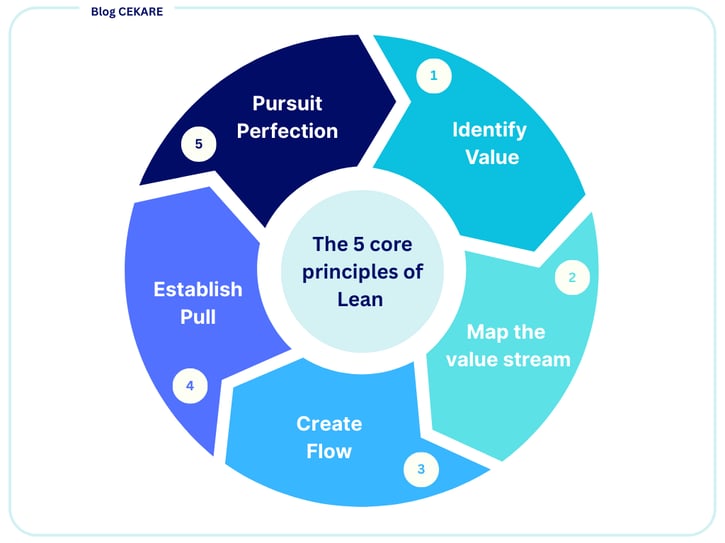Blog CEKARE #7
The 5 core principles of Lean Management.
By Baptiste CARRE, 15/05/2025.
Time to read : 5 min


Businesses face constant pressure to deliver more value with fewer resources. Enter Lean Management, a philosophy rooted in maximizing customer value while minimizing waste. But what exactly does that mean in practice? It all begins with five foundational principles.
Whether you're just beginning your Lean journey or seeking to reinforce an existing approach, understanding these five principles is essential for cultivating a culture of continuous improvement.
SUMMARY
Understanding Lean Management
Lean Management is a structured and systematic approach to improving efficiency and effectiveness in organizations. Originating from the Toyota Production System, Lean centers on delivering more value to customers using fewer resources by cutting out waste : any activity that does not add value to the final product or service.
Since its inception, Lean principles has expanded beyond manufacturing. Today, it drives transformation in all industries such as healthcare, logistics, software development, and professional services. Regardless of the sector, its promise remains the same: do more with less, without sacrificing quality.
Lean encourages organizations to focus on what truly matters to the customer, streamline workflows, empower employees at every level, and adapt quickly to change. It's not just a set of tools or techniques, it's a mindset and a management philosophy that shapes how work is done.
One of Lean’s greatest strengths lies in its scalability. Whether you're refining a single process or transforming your entire business model, Lean offers a flexible and structured path to operational excellence.
It all begins with five core principles that can be directly applied across any businesses :
Identify Value
Map the Value Stream
Create Flow
Establish Pull
Pursue Perfection
By adopting these principles, organizations can streamline their processes, reduce lead times, improve quality, and enhance customer satisfaction.


1. Identify Value.
The first step of Lean Management is crucial: defining value from the customer's perspective. Value isn’t what customers want, it's what they are willing to pay for. To truly understand value, we need to step into our customers' shoes and understand what solves their problems, saves them time or makes their life easier. Assumptions and internal goals are not enough and can’t be taken for granted, aligning processes with customer needs is essential.
Consider a company that manufactures smartphones. Customers value features like battery life, camera quality, and user-friendly interfaces. By focusing on these aspects, the company can eliminate non essential features, such as excessive packaging or bloated software.
💡 Engage directly with your customers. Surveys, interviews, or even a day-in-the-life observation can help uncover insights that internal metrics might miss. Define which specific features or services do your customers value the most in your product.
2. Map the Value Stream.
Once value is clearly defined, the next step is to map the value stream. This involves identifying the full sequences of steps and activities required to deliver a product or service, as detailed as possible - from raw materials to the end customer.
The purpose of mapping the value stream is to :
Gain a comprehensive understanding of how value flows through the organization
Identify and eliminate waste—steps that consume resources without creating value.
This second principle enables cross-functional teams to visually document existing processes. It highlights delays, rework loops, unnecessary approvals, and other inefficiencies. By mapping the value stream, organizations can enhance transparency and alignment across departments, make data-driven decisions for process improvement, and establish a common framework for continuous dialogue and iteration.
💡 Using Value Stream Mapping (VSM) tools such as Microsoft Vision to create a detailed representation of your current processes. Analyze each step and highlight areas where waste occurs, such as delays, redundancies, or unnecessary steps.
3. Create Flow.
Next, we encounter the principle of creating flow. Flow ensures that operations proceed smoothly without interruptions or bottlenecks. Creating flow means organizing people, tools, materials, workplaces and information so that value is continuously delivered. It also involves simplifying complex steps, improving handoffs between teams, and minimizing waiting times.
When flow is disrupted, inefficiencies remain hidden and waste accumulates. In contrast, a smooth flow makes problems visible early and solvable in real time.
In a manufacturing context, flow might mean a production line where components move from station to station without pause. In a software team, it might mean reducing delays between design, development, and testing.
To create a smooth flow, consider the following actions :
Standardize processes to reduce variation and ambiguity.
Balance workloads to prevent overburdening resources while others remain idle.
Design workflows that are intuitive and self-reinforcing.
💡 Adopt Kanban boards and workflow management software to visualize and streamline workflows. Ask yourself how you can reorganize tasks or resources to reduce delays and improve continuity ?
4. Establish Pull.
The fourth principle focuses on establishing a pull system. Pull means producing only what is needed, when it is needed, based on actual customer demand. This principle helps avoid overproduction and reduce inventory costs.
In traditional “push” systems, work is scheduled based on projections and often leads to overproduction, excess inventory, and misaligned priorities. In contrast, a pull system ensures that production or service delivery happens only when there is a clear signal of demand.
Pull systems are relevant not just in manufacturing, but they also apply in service and knowledge work environments. For example In IT, developers may only pick up tasks when there is capacity and a clear user need. In healthcare, medical supplies are restocked based on real-time usage rather than fixed intervals.
💡 How can your organization implement a pull system to better align production with customer demand? Consider implementing Just-in-Time (JIT) systems to manage supplies only when it’s needed.
5. Pursue Perfection.
The final and perhaps the most transformative principle is the pursuit of perfection. In practice, reaching perfection may be unattainable but the pursuit itself drives a culture of innovation, discipline, and relentless improvement.
This principle is grounded in the Japanese concept of Kaizen, which means "change for better.". It involves a commitment to empower and encourage every employee at all levels to identify and act on opportunities for continuous improvements, no matter how small.
Organizations that embrace this principle are better equipped to adapt, compete, and thrive over time. They continually challenge the status quo, measure performance, and build learning into every layer of the business.
Key elements of continuous improvement include:
Empowering frontline employees to identify and solve problems.
Implementing structured problem-solving routines (e.g., PDCA cycles).
Recognizing and celebrating progress, not just outcomes.
💡 Foster a culture of continuous improvement by regularly reviewing processes, seeking feedback, engaging everyone and celebrating small wins to maintain momentum.
Ready to take the first step ?
By applying five principles of Lean Management - Identifying value, Mapping the value stream, Creating flow, Establishing pull, and Pursuing perfection - organizations can unlock new levels of efficiency, agility and customer satisfaction.
Lean is not a one-time project. It is a long-term commitment to doing better every day. With the right mindset, tools, and support, any organization can thrive.
Want to bring Lean thinking into your organization?
CEKARE supports companies to apply these principles through tailored training, coaching, and implementation services. Reach out to learn how Lean can work for you : no matter your size or industry.
CEKARE
Boost your operational and industrial performance.
Mail : contact@cekare.eu
Phone : +370 663 58 502
© 2025. All rights reserved.
